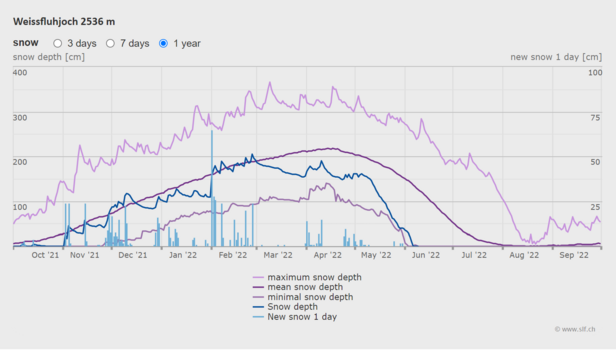09.06.2022 | Roman Oester | News SLF
The snow ablation date at the SLF test site on the Weissfluhjoch was 6 June 2022. This is the second earliest date since manual measurements began in winter 1936/37. A striking feature of the statistics is that the earliest snow ablation dates have occurred predominantly in the last 30 years. Another record was broken outright in winter 2021/22.
Eighty-six years ago, the "Expert Commission for Snow and Avalanche Research in Switzerland" began to carry out continuous, manual snow measurements on the Weissfluhjoch above Davos. For the SLF, that work is over for the time being, as Monday, 6 June 2022 marked the official date of snow ablation (Ausaperung in German). This means that more than half of the measuring site is free from snow. The statistics show that winter snow cover measurements are coming to an end increasingly early, with seven out of the ten earliest ablation dates being within the past 30 years. Moreover, this year's early-June date is almost a record-breaker, falling just three days later than the earliest such date in 1947.
Webcam shots of the Weissfluhjoch test site between 29 May and 6 June 2022, taken at 8 o'clock. Photo: SLF
More interesting facts about early snow ablation ¶
- As in 1947, the SLF reported several major Saharan dust events in winter 2021/22, which contributed to the rapid melting.
- The snow had been melting continuously since 1 May 2022, when it measured 161 cm, 20 cm more than on the same day in the record year of 1947.
- The snow depth last winter peaked on 16 February 2022 at 205 cm, which was about an average depth.
- However, the total amount of new fallen snow was 663 cm, well below the average of just under 10 m.
- The snow ablation date on the Weissfluhjoch has advanced by 1.2 days per decade since measurements began: the current average is 28 June, compared with 11 July in the middle of the 20th century.
- Last winter saw the shortest duration of snow cover since records began, with snow lying on the Weissfluhjoch test site for 'only' 216 days. By comparison, snow cover in winter 1973/74 lasted over three months longer (315 days). This short duration is also not an isolated case, but part of a more general trend over the past 30 years.
| Rank | Snow ablation date | Snow cover duration |
| 1 | 3 June 1947 | 216 days (winter 2021/22) |
| 2 | 6 June 2022 | 220 days (winter 2016/17) |
| 3 | 9 June 2011 | 221 days (winter 2006/07) |
| 4 | 10 June 2007 | 221 days (winter 1948/49) |
Table: Earliest snow ablation dates and shortest snow cover durations: three out of four of these have occurred in the last 15 years. Winter 2021/22 (shown in bold) is in the top four for both.
Links ¶
Contact ¶
Copyright ¶
WSL and SLF provide the artwork for imaging of press articles relating to this media release for free. Transferring and saving the images in image databases and saving of images by third parties is not allowed.

